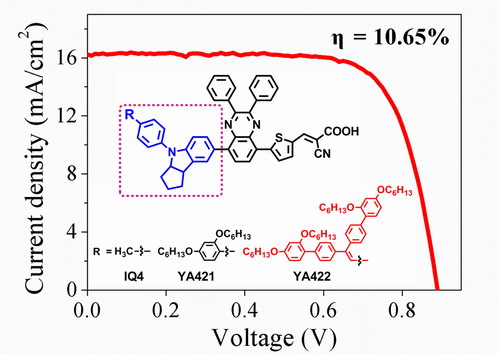Recently, a paper of “Influence of the Donor Size in D−π–A Organic Dyes for Dye-Sensitized Solar Cells” was published in Journal of the American Chemical Society (J. Am. Chem. Soc., 2014, 136 (15): 5722–5730. http://pubs.acs.org/doi/pdf/10.1021/ja500280r). This work was cooperatively published by Prof. Jianli Hua group (School of Chemistry and Molecular Engineering, East China University of Science & Technology) and Prof. Michael Grätzel group (Laboratory of Photonics and Interfaces, Swiss Federal Institute of Technology Lausanne). In this research, the highest power conversion efficiency of 10.65% in the field of dye-sensitized solar cells (DSSCs) by employing a single organic D-π-A dye was recorded.
Two new molecularly engineered push-pull dyes, i.e. YA421 and YA422, based on substituted quinoxaline as a π-conjugating linker and bulky-indoline moiety as donor and compared with reported IQ4 dye were reported. Benefitting from increased steric hindrance with the introduction of bis(2,4-dihexyloxy)benzene substitution on the quinoxaline, the electron recombination between redox electrolyte and the TiO2 surface is reduced, especially in redox electrolyte employing Co(II/III) complexes as redox shuttles. It was found that the open circuit photovoltages of IQ4, YA421 and YA422 devices with cobalt-based electrolyte are higher than those with iodide/triiodide electrolyte by 34 mV, 62 mV and 135 mV, respectively. Moreover, the cells employing graphene nanoplatelets on top of gold spattered film as a counter electrode (CE) show lower charge transfer resistance compared to platinum as a CE.
Consequently, YA422 devices deliver the best power conversion efficiency due to higher fill factor, reaching 10.65% at AM 1.5 simulated sunlight. Electrochemical impedance spectroscopy and transient absorption spectroscopy analysis were performed to understand the electrolyte influence on the device performances with different counter electrode materials and donor structures of D-π-A dyes. Laser flash photolysis experiments indicate that even though the dye regeneration of YA422 is slower than that of the other two dyes, the slower back electron transfer of YA422 contributes to the higher device performance.

This research was completed by Ph. D candidate Jiabao Yang and other coworkers with the direction of Dr. Shaik. M. Zakeeruddin and Prof. Jianli Hua. This work was supported by NSFC/China (2116110444, 21172073, 91233207 and 21372082) and the National Basic Research 973 Program (2013CB733700). Jiabao Yang would like to thank the funding of the visiting program, which is supported by China Scholarship Council (CSC).




